|
<< Click to Display Table of Contents >> Rseries and Rshunt determination procedure |
  
|
|
<< Click to Display Table of Contents >> Rseries and Rshunt determination procedure |
  
|
The previous topic Model parameters besides Datasheets defines the resistances involved in the one-diode model.
This explains that the Low-light performance (relative efficiency) is determined by the RSerie, RShunt and RShunt(0) parameters.
When entering the page "Model parameters > Rshunt-Rserie" in the PV module definition dialog, you are advised to choose "Relative effic." for seing the graph of the Low-light behaviour:
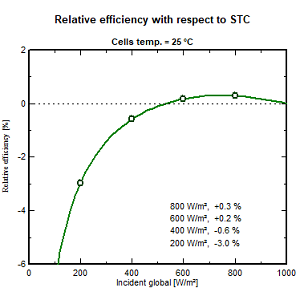
You can easily check by playing with the parameters that this low-light efficiency behavior depends on the 3 mentioned resistances:
| - | Increasing Rshunt will increase the low-light efficiency. |
| - | Increasing RShunt(0) (on the next page "RShunt expon.") , will also increase the low-light efficiency |
| - | Increasing RSerie also increases the Low-light performance. |
Default values
| - | The RShunt default value is based on the STC parameters: it is 0.2 x the "conductance" defined by the MPP: Rshunt(default) = Vmp / (0.2 x (Isc - Imp)). |
| - | The Rshunt(0) default value is 4 x Rshunt for Crystalline modules, and 12 x Rshunt for most other technologies (thin film). |
| - | The RSerie default is set in order to obtain a relative efficiency at 200 W/m² = -3%. |
| - | The RshExp exponential coefficient is always -5.5, according to all our measurements of Rshunt at sun. This should not be modified. |
The key point here is that the main default condition is based on the relative efficiency @ 200 W/m² = -3%. The RSeries is adjusted to obtain this condition, whatever the Rshunt and Rshunt(0) values. Therefore usually, when manipulating these values you don't notice that the low-light behavior is also depending on them.
Constraints between these values
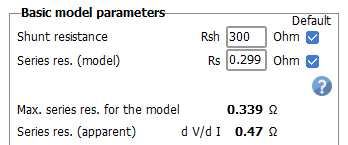
These variables are strongly interdependent.
| - | The Rseries cannot exceed the Maximum value (RSerieMax) shown on this dialog (here 0.339 Ω). This may limit the desired Low-light performance. |
| - | The RSerieMax. is dependent on the RShunt value: it can be increased by increasing RShunt, but only up to some limited extent (saturation) as seen on this example graph: |
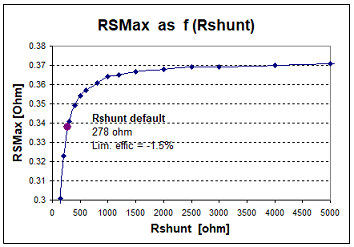
Therefore, when the desired Relative Efficiency cannot be reached, it is necessary to increase the Rshunt in order to increase the RSerieMax.
Vmp/Voc ratio limitation
The RSerieMax is also limited by the Vmp/Voc ratio at STC.
The next graph shows the evolution of RSMax, which is linearly but quickly decreasing with the Vmp/Voc ratio. You can notice that we have a decrease of -50% for an increase of only 3% of the Vmp/Voc ratio.
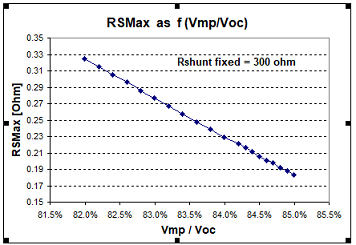
In practice, Vmp/Voc ratios greater than around 84% should be avoided.
Some manufacturers artificially decrease their Voc value, probably in order to increase the Fill Factor. We have sometimes observed values greater than 84% on the datasheet specifications, when the detailed measurements provided by an independent laboratory showed values below 82 or 83%.
The next graph shows examples of the possible low-light efficiencies as a function of Rshunt and Vmp/Voc.
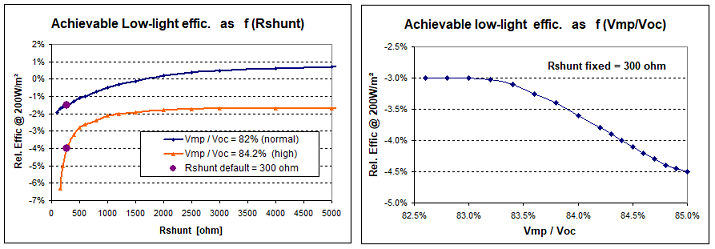
Additional constraint: low temperature behavior
When Rserie is close to RserieMax, the establishment of the model leads to very low diode saturation current (IoRef) as well as a low diode ideality factor (Gamma, up to 0.92).
Now the diode saturation current Io is highly varying with the temperature: i.e. by a factor of the order of 10'000 between + 25°C and -10°C ! Due to numeric problems with the exponential, PVsyst has to put a lower limit to the temperature-dependent Io value. This limit is extremely low (0.01 pA), but when it is reached the temperature behavior of the model is altered, the muPmpp thermal coefficient changes sign.
When establishing the default, PVsyst tries to push this limit below -10°C, by increasing the RserieMax value so that the suited default Rserie is not so close. This use the same arguments as previously: increasing Rshunt, and possibly Voc is this is not sufficient.
Establishing the default values for RSerie and RShunt
When RSerie and RShunt are not defined in the PAN file (most of the cases), PVsyst has to determine default values.
As mentioned previously, this default is characterized by the Low-light relative efficiency = -3% at 200 W/m².
The procedure is as follows:
| - | Rshunt is set to its default value according to STC. |
| - | PVsyst tries to adjust Rserie for getting the required Efficiency. |
| - | If this is not achievable, PVsyst increases RShunt until this efficiency can be reached (up to 4 x Rshunt initial). |
| - | If this is still not achievable, PVsyst has to increase the Voc value. The required increase is usually very limited (some little fraction of percent). |
| - | Check of the Temperature coefficient muPmpp at -10°C. If this is positive, increases RSMax again, by increasing RShunt and possibly Voc. |
This procedure is applied when reading the PAN file from the database, when RShunt and RSerie are not defined. You can also execute it by clicking the default cases for Rshunt and RSerie.